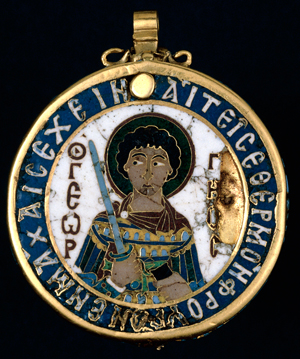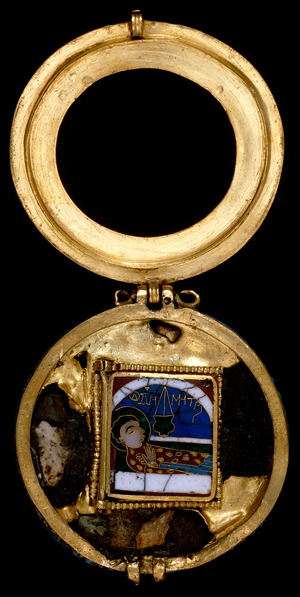Reliquary Pendant of St. Demetrios with St. George
The British Museum, London
Copyright © The Trustees of the British Museum

 Select the image to zoom
Select the image to zoom
A handful of personal reliquaries of St. Demetrios have survived, each incorporating small interior shuttered compartments for relics and depictions of the saint. The relics of Demetrios were not his bones, but oil or myron collected from his tomb and blood-soaked earth taken from the site of his martyrdom. The owners of the reliquaries would have had to move through several layers, opening first the lid of the reliquary and then the shutters covering the interior compartments, before finally seeing the relics and the innermost depiction of the saint.
Two of these reliquaries are in the form of circular pendants, meant to be worn around the neck of the owner, with hinged lids allowing access to the reliquary compartments inside. The upper lid of the London reliquary was replaced with an open ring in the eighteenth century, but the inscription on the side of the reliquary refers to Demetrios, and the interior compartment is similar to those of other Demetrios reliquaries, so it is likely that Demetrios was depicted on its lost lid, in a manner similar to the representation on the Washington pendant (cat. no. 29). Demetrios was the patron saint of Thessalonike, and a large festival in his honor was held there every year in October, coinciding with his feast day (26 October). These reliquaries, like many objects associated with Demetrios, have been attributed to workshops in Thessalonike, but given the saint's popularity with members of the imperial family and the aristocracy, and scant evidence of any enamel workshops in Thessalonike, production in the Byzantine capital, Constantinople, should also be considered.
From the eleventh century onwards Demetrios became increasingly popular among the military classes in the Byzantine Empire, and he was often depicted as a soldier and paired with other military saints. St. George, another popular soldier saint, is depicted on the back of the London reliquary. André Grabar, following O.M. Dalton, suggested that the lamp suspended over the tomb of the saint in this reliquary was a reflection of Crusader influence. Similar iconography was used in certain Crusader contexts, but such lamps had long been associated with the tombs of a number of Byzantine saints, including, significantly, St. Theodora, another myron-producing saint of Thessalonike with whom Demetrios was often associated.






